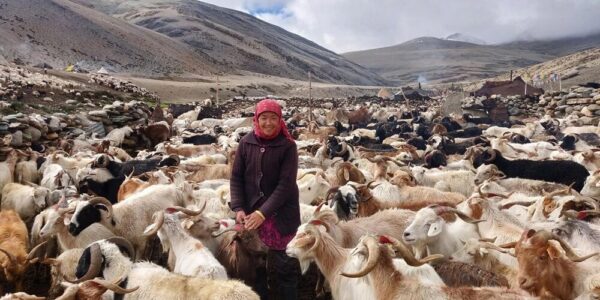The Plight of Changpa Nomadic Tribe
The Changpas reside on this high-altitude plateau that sprawls in the western and northern parts of Tibet and further extends to Ladakh in India. Most of the regions that the Changpas reside in are quite inhospitable and unsuitable for farming. Thus, the primary occupation of the tribe is the rearing of yaks, horses, and sheep.
The famous “Pashmina” goats, whose soft wool is famous throughout the world, is found in this region. Pashmina, a highly coveted cashmere wool, comes from the fine undercoat of a breed of Himalayan goat found in India, Nepal, Tibet, and Central Asia. But the pashmina from Changtang is seen by purists as the best. For this exceptionally warm, light, and fine fibre, the animals need the particular climatic conditions of Changpa’s homeland.
The Changpas move from one green land to another to rear the animals, also using them to produce cheese and milk. The Chinese Army’s intrusion in Chumur and Demchok has left Ladakh’s nomadic herding Changpa community cut off from large parts of summer pastures.
* Click to Follow Voice of Ladakh on WhatsApp *
This incursion has destabilised the annual seasonal migration of livestock, including yaks and Pashmina goats. Among the Ladakh Changpa, those who are still nomadic are known as Phalpa, and they take their herds from the Hanley Valley to the village of Lato.
The Changpa speak Changskhat, a dialect of Tibetan, and practice Tibetan Buddhism. Academic accounts state that they migrated from Tibet in the eighth century AD and came to the Changthang region in India, a western extension of the Tibetan Plateau, across the Himalayas.
This area, located near the India-China border, is closed to foreign nationals, and even Indians must obtain a special permit from Leh. The ongoing dispute has posed a considerable threat to the fragile ecology of the area and, consequently, the lives of the nomadic tribe. The increasing attractions of alternative livelihoods, an influx of tourism in the area, and some significant climate changes, such as unnaturally heavy snowfalls resulting in the deaths of livestock in recent years, have only added to the threats that the Changpa now face.
A recent tie-up between Khadi and the Village Industries Commission (KVIC) and Khadi institutions from Varanasi and Ghazipur in Uttar Pradesh for processing Pashmina wool primarily produced in the Ladakh region has concerned Pashmina artisans and traders in Kashmir. A few years ago, Khadi institutions in Varanasi purchased 500 kg of raw Pashmina wool from Leh, which was brought to Delhi for processing. The raw material—pashmina wool required for hand spinning and weaving into pashmina shawls—comes from special goats (Capra hircus) reared at an altitude of 12,000 to 14,000 feet. These graze in Ladakh and the higher reaches of Tibet’s Chang-Thang region.
Pashmina weaving was slated to start in January 2022 in Varanasi, where 20 Khadi artisans would go through 30 days of training in weaving processed Pashmina wool.
The Changpas are Buddhists and followers of the Dalai Lama. Their Buddhist belief does not allow them to kill animals for meat. It is only when animals die a natural death that the carcasses can be used for meat and hide, which the Changpas use to line their huts and make
garments. As the climate becomes unpredictable, the quality of the wool declines. The Changpas supply nearly 80 percent of the wool consumed by the Jammu and Kashmir region, as per data provided by the Animal Husbandry Department of Ladakh. The wool is getting thinner, and the Changpas live in constant fear of the situation getting worse. In 1989, the Changpa were granted official status in India as a Scheduled Tribe.

0 Comments